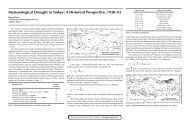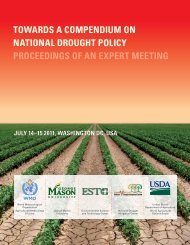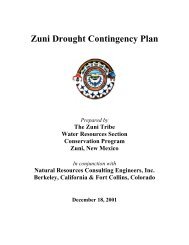Using <strong>the</strong> SPI to Identify <strong>Drought</strong>This article was written in response to <strong>the</strong> recentanalysis of drought in Turkey by Komuscu (1999).The study showed <strong>the</strong> relationship between droughtduration, drought frequency, and drought time scaleusing <strong>the</strong> Standardized Precipitation Index (SPI):whereSPI = (X ik- X i)ó ió i= standardized deviation for <strong>the</strong> ith stationX ik= precipitation for <strong>the</strong> ith station and kth observationX i= mean precipitation for <strong>the</strong> ith stationThe index has <strong>the</strong> advantages of being easilycalculated, having modest data requirements, andbeing independent of <strong>the</strong> magnitude of mean rainfalland hence comparable over a range of climatic zones.It does, however, assume <strong>the</strong> data are normally distributed,and this can introduce complications forshorter time periods. Komuscu claims that <strong>the</strong> SPI hasnot been widely applied or tested and employs <strong>the</strong>drought classes suggested by McKee et al. (1995),reproduced here in Table 1.The SPI is of course <strong>the</strong> same as <strong>the</strong> StandardizedRainfall Anomaly, defined by Jones and Hulme(1996) and widely used in <strong>the</strong> analysis of desiccationin drylands. Figure 1 shows a typical example of suchuse, depicting <strong>the</strong> widely reported downward trend inSahelian rainfalls (only continental Sahelian stationsare employed after <strong>the</strong> suggestions of Ba et al. [1995],Janicot et al. [1998], and Nicholson and Palao [1993]that o<strong>the</strong>r parts of West Africa belong to a differentclimate regime). Komuscu’s assertion that <strong>the</strong> SPI isunderused for drought assessment appears to becorrect, in that it is <strong>the</strong> persistence of <strong>the</strong> negativeanomalies that receives most attention ra<strong>the</strong>r than anexamination of <strong>the</strong>ir intensity or impact (for example,see Hulme, 1992). That is, rainfall anomalies are usedto investigate desiccation ra<strong>the</strong>r than drought (seeAgnew, 1995, for fur<strong>the</strong>r discussion). The purpose ofthis paper is <strong>the</strong>n to question <strong>the</strong> values assigned to <strong>the</strong>SPI for drought classes and to suggest alternative,more rational thresholds. The effect of using differentdrought classes is investigated using annual rainfallsfrom <strong>the</strong> Sahelian region of West Africa, and <strong>the</strong>SPI Probability Komuscu (1999) and Proposed newof occurrence McKee et al. (1995) drought classesdrought classesLess than -2.00 0.023 Extreme droughtLess than -1.65 0.050 Extreme droughtLess than -1.50 0.067 Severe droughtLess than -1.28 0.100 Severe droughtLess than -1.00 0.159 Moderate droughtLess than -0.84 0.201 Moderate droughtLess than -0.50 0.309 No droughtLess than 0.00 0.500 Mild drought No droughtTable 1. Probabilities for different standardized rainfall anomalies.6 Vol. 12, No. 1, Winter 1999–Spring 2000
21.5Standardized Rainfall Anomaly10.50-0.5-1-1.5-21930 1940 1950 1960 1970 1980 1990Figure 1. Standardized annual precipitation anomalies for <strong>the</strong> continental Sahel (Burkina Faso, Mali, and Niger), using <strong>the</strong>1961–90 base period.problem of changing <strong>the</strong> base averaging periods ispresented.What is Meteorological <strong>Drought</strong>?This question has been addressed time and again(Agnew and Anderson, 1992; Wilhite, 1993), and ithas often been stated that no universal definition ofdrought exists. There is little to be gained by reproducinga long list of conflicting definitions that merelyillustrate <strong>the</strong> diverse interests of those who investigatedrought. Most definitions anyway can be resolvedinto a generic statement that drought is caused by animbalance between water supply and demand. Hencedrought can be defined in terms of both supplyreduction and demand increase, and <strong>the</strong>re are numerousdefinitions of hydrological, agricultural, ecological,and economic drought that demonstrate this.Many, however, agree with Palmer (1965) and Beranand Rodier (1985) that drought is essentially a meteorologicalphenomenon. The analysis below adoptsthis perspective—that examining <strong>the</strong> occurrence ofmeteorological drought is <strong>the</strong> most fundamental requirementof any investigation.The second premise of this account is that droughtis an abnormal occurrence. This is an equally importantpoint and it is <strong>the</strong> reason why it is suggested thatTable 1 should not be used without modification fordrought analysis. In McKee’s classification (McKeeet al., 1995), all negative indexes (SPI) are taken toindicate <strong>the</strong> occurrence of drought; this means for50% of <strong>the</strong> time, drought is occurring. This is clearlynonsense! It also raises <strong>the</strong> notion of “persistent<strong>Drought</strong> Network News7








